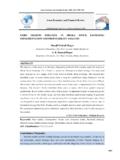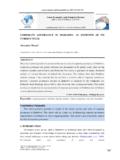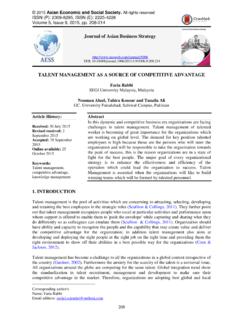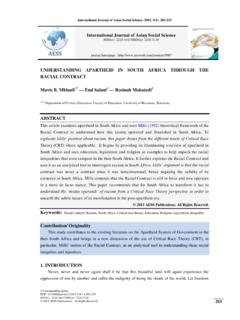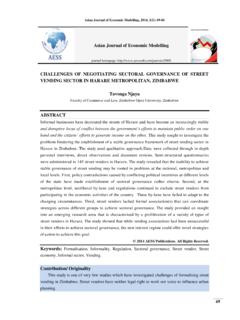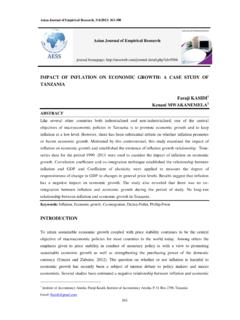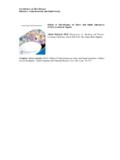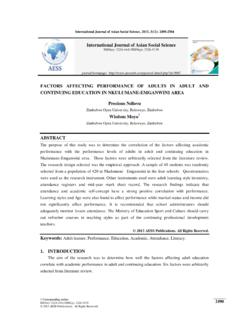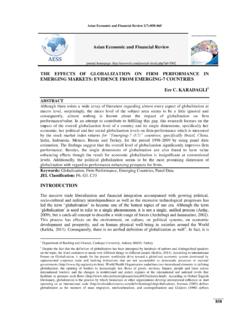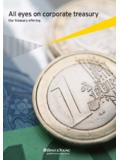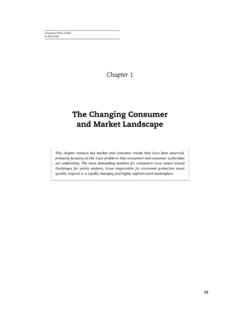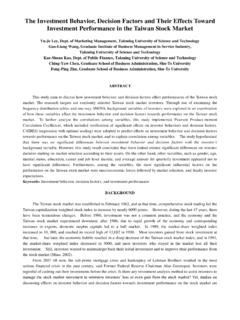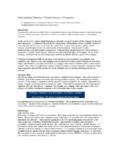Transcription of THE EFFECT OF EXCHANGE RATE FLUCTUATIONS …
1 Asian economic and Financial Review, 2014, 4(4): 517-528 517 THE EFFECT OF EXCHANGE RATE FLUCTUATIONS ON economic growth CONSIDERING THE LEVEL OF DEVELOPMENT OF FINANCIAL MARKETS IN SELECTED DEVELOPING COUNTRIES Mehdi Basirat Assistant Professor and Head of Economics Department, Science and Research Branch, Islamic Azad University, Khuzestan, Iran Arezoo Nasirpour MA student, Department of Economics, Science and Research Branch, Islamic Azad University, Khuzestan, Iran Alireza Jorjorzadeh Assistant Professor Department of Economics, Science and Research Branch, Islamic Azad University, Khuzestan, Iran ABSTRACT This study aimed to investigate the EFFECT of EXCHANGE rate FLUCTUATIONS on economic growth considering the rate of development of financial markets in developing countries over the period 1986-2010.
2 The effects of variables such as trading volume, inflation, and production of the previous period on economic growth have been studied as well. The results obtained by analyzing panel data of 18 countries show that the EFFECT of financial development on economic growth as well as the EFFECT of EXCHANGE rate fluctuation on economic growth are negative and significant. On the other hand, the mutual EFFECT of EXCHANGE rate FLUCTUATIONS and financial development on economic growth is positive, but the EFFECT in the studied countries is so small that is not statistically significant. Keywords: The currency fluctuation, economic growth , Financial development, Panel data. Classification: 016, C23, 004, F31. 1. INTRODUCTION The EXCHANGE systems over the last few years have experienced many ups and downs at the international level and have affected the economic structures of some countries.
3 Different EXCHANGE systems show how EXCHANGE rate is determined in an economy. EXCHANGE rate over the years, especially after the collapse of the fixed EXCHANGE rate system (the Bretton Woods system) has had many FLUCTUATIONS (Ehsani et al., 2009). Furthermore, one of the most important issues in Asian economic and Financial Review journal homepage: Asian economic and Financial Review, 2014, 4(4): 517-528 518 developing countries after World War II has been the economic growth . Among the important factors that affect economic growth , has been EXCHANGE rate fluctuation. The EFFECT of EXCHANGE rate FLUCTUATIONS on economic growth varies in different countries. It can be said that one of the factors determining the way EXCHANGE rate FLUCTUATIONS affect economic growth is the development level of each country's financial markets.
4 New theories emphasize the high correlation between economic growth and innovation. This innovation in financial markets occurs by introducing new tools of financial development and in the real sectors of the economy with the introduction of new products. In fact, with the arrival of the financial intermediaries to growth models, by introducing new tools of finance and financial development, goals such as reducing risk, increasing capital efficiency through optimal resource allocation and mobility of savings are taken into consideration that eventually follow the objective of achieving long-term growth of the economy (Hosseini et al., 2011). Studies suggest that when financial markets are developed enough, the EXCHANGE rate FLUCTUATIONS will not have a negative EFFECT on economic growth , while when financial markets are undeveloped, EXCHANGE rate FLUCTUATIONS will hinder economic growth .
5 This study examines the EFFECT of EXCHANGE rate FLUCTUATIONS on economic growth considering the level of development of financial markets in developing countries and in this respect the following questions are raised: 1 - Does the development of financial markets have a positive EFFECT on economic growth ? 2 - Do the EXCHANGE rate FLUCTUATIONS have a negative EFFECT on economic growth ? 3 - Does development of financial markets neutralize the negative EFFECT of EXCHANGE rate FLUCTUATIONS on economic growth ? 2 .THEORETICAL FOUNDATIONS Real EXCHANGE Rate and economic growth economic growth is one of the main objectives of economic policy and economic decision-making. Among economic variables, the variable which is most closely and directly related to the external sector of the economy and more than any other variable can provide economic growth is the macroeconomic variable of real EXCHANGE rate because fluctuation of real EXCHANGE rate can cause high fluctuation in foreign trade and balance of payments.
6 Today, due to deep changes in EXCHANGE systems, the EXCHANGE rate shows off as a key factor in economic policy making more than ever (Jafari, 1999). On the other hand, one of the effective factors in choosing the appropriate EXCHANGE system in developing countries is the relationship between real EXCHANGE rate and economic growth . Choosing ineffective EXCHANGE system and inappropriate EXCHANGE policies in many countries has had negative effects on their economic growth . FLUCTUATIONS of real EXCHANGE rate in a flexible EXCHANGE system make ample changes in investment and international trade, thereby on economic growth . Many countries, to avoid EXCHANGE rate FLUCTUATIONS , fix the value of their currency against the most important currencies. However, it is observed that some other countries refuse to fix the EXCHANGE rate and accept the floating EXCHANGE rate systems, to accept EXCHANGE rate FLUCTUATIONS .
7 Asian economic and Financial Review, 2014, 4(4): 517-528 519 The point worthy of attention is that the observations show some difficulties such as negative effects on economic growth are raised as the result of applying floating EXCHANGE rate systems and the resulted EXCHANGE rate FLUCTUATIONS in some countries, while in many other countries most of which are developed countries such negative effects are not observed . This dichotomy suggests that the EFFECT of EXCHANGE rate FLUCTUATIONS on important variables such as economic growth depends on a third factor named the level of financial development. Development of Financial Markets and economic growth Since capital accumulation is one of the major sources of every economy, capital formation process can be accelerated through financial markets (Khataee and Khavari, 1999).
8 In the Keynesian models of growth , since Keynes introduces function of investment as inverse function of interest rates and savings function as direct function of income, lower interest rates is proposed. McKinnon and Shaw rejected Keynes' monetary models, Keynesians and structuralists theories and believed that the main assumptions of these approaches did not suit the conditions in developing countries of that time. They emphasized the key role of liberalization and financial development on economic growth and showed that the financial repression, that is, stabilizing the nominal interest rate below the equilibrium level of real interest rates , by limiting real investment and the amount of savings would lead to the slowdown of economic growth . Neostructuralists, represented by Edward Buffie (1984), Akira Kohsaka (1984), Lance Taylor (1983), and Sweder Van Wijnbergen (1983a and 1983b), challenged McKinnon - Shaw School in the early 1980s.
9 According to these neostructuralists, in practice, financial liberalization, most likely is due to reduced real granting of credits available to businesses, reduces economic growth . Neostructuralists assume that financial resources are freely flowing between banking system and the unorganized markets, and any increase in unorganized market interest rates , increases the prices level. In their analysis, eliminating interest rate ceilings will increase deposits interest rate and through increasing unorganized market interest rates may reduce total supply of circulating capital, thereby decrease economic growth (Komeyjani and Pourrostami, 2008). Patrick (1966) argues that in the early stages of economic development, the financial sector causes economic growth by expanding and providing capital and in the next stages when economy is growing, the demand for financial services is enhanced and leads to financial development.
10 3. LITERATURE REVIEW Rioja and Valev (2002) showed that the relationship between financial development and growth is not a one-to-one monotonic relation and depends on their level of financial development. Their study shows that in countries with low levels of financial development, some indices of financial development have negative effects on growth , while some others have positive but very low and negligible effects. In countries with intermediate levels of financial development, financial development indices have a positive EFFECT greater than that of countries with advanced financial development on growth . Nili and Rastad (2003) examined the relationship between financial Asian economic and Financial Review, 2014, 4(4): 517-528 520 markets and economic growth and investigated the effects of four fundamental, structural and efficiency indices of financial development as well as the ratio of time or savings deposits to GDP and three economic performance indices, including economic growth , per capita capital accumulation growth and capital productivity.
